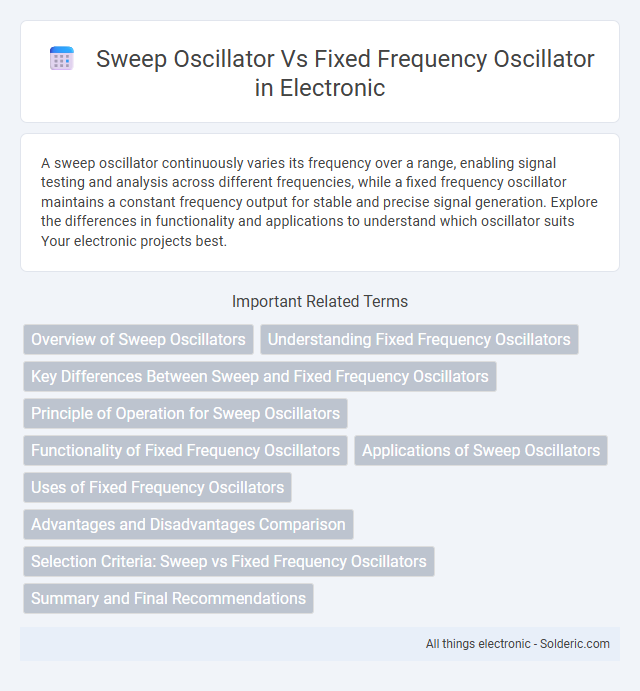A sweep oscillator continuously varies its frequency over a range, enabling signal testing and analysis across different frequencies, while a fixed frequency oscillator maintains a constant frequency output for stable and precise signal generation. Explore the differences in functionality and applications to understand which oscillator suits Your electronic projects best.
Comparison Table
| Feature | Sweep Oscillator | Fixed Frequency Oscillator |
|---|---|---|
| Definition | Generates signals with continuously varying frequency over time | Generates signals at a single, stable frequency |
| Frequency Range | Wide, adjustable frequency range within sweep limits | Narrow, fixed at a designated frequency |
| Applications | Frequency response testing, radar, signal analysis | Clock generation, carrier signals, fixed-tone generation |
| Output Stability | Frequency changes continuously; less stable at a given instant | Highly stable and consistent frequency output |
| Complexity | More complex circuitry to enable frequency sweeping | Simpler circuit design focusing on frequency stability |
| Control | Frequency controlled by external sweep signal or control voltage | Frequency set by fixed components like crystal or LC circuit |
Overview of Sweep Oscillators
Sweep oscillators generate a continuously varying output frequency over a specified range, enabling dynamic frequency analysis and testing in electronic circuits. These oscillators are essential in applications such as signal generation for spectrum analyzers, radar systems, and communication testing, where frequency agility is crucial. Unlike fixed frequency oscillators that maintain a constant frequency output, sweep oscillators provide a controlled frequency sweep, enhancing the ability to identify frequency-dependent behaviors and responses.
Understanding Fixed Frequency Oscillators
Fixed frequency oscillators generate a stable output signal with a constant frequency, crucial for applications requiring precise timing or consistent signal generation. These oscillators use components like quartz crystals or LC circuits to maintain frequency stability over various conditions. Understanding fixed frequency oscillators helps you select the right device for tasks needing reliable, unchanging signal frequencies.
Key Differences Between Sweep and Fixed Frequency Oscillators
Sweep oscillators continuously vary their output frequency over a specified range, enabling frequency response analysis and signal testing across multiple frequencies. Fixed frequency oscillators generate a stable, constant frequency output, ideal for applications requiring a single accurate tone or carrier wave. Sweep oscillators find use in spectrum analyzers and radar systems, whereas fixed frequency oscillators are commonly employed in clocks and communication transmitters.
Principle of Operation for Sweep Oscillators
Sweep oscillators operate by continuously varying their output frequency over a specific range, typically using voltage-controlled components such as varactor diodes or voltage-controlled capacitors to achieve frequency modulation. This controlled frequency sweep enables applications in signal analysis, testing of frequency response, and radar systems. Fixed frequency oscillators generate a stable output at a single, predetermined frequency using constant resonant elements like crystal oscillators or LC circuits, offering high precision but lacking frequency variability.
Functionality of Fixed Frequency Oscillators
Fixed frequency oscillators generate a stable and precise output signal at a constant frequency, essential for applications requiring consistent timing or signal reference. They maintain frequency stability through components like quartz crystals or LC circuits, ensuring minimal drift over time and varying conditions. Your equipment relies on fixed frequency oscillators to provide reliable, repeatable signals critical for communication systems, clocks, and signal processing tasks.
Applications of Sweep Oscillators
Sweep oscillators are primarily used in applications requiring frequency modulation over a range, such as radar systems, signal analysis, and electronic testing, where varying frequencies help identify and diagnose circuit behaviors. Unlike fixed frequency oscillators that generate a single, stable frequency mainly used in clock signals and communication systems, sweep oscillators enable frequency response measurements and frequency hopping in wireless communication. Your electronic designs benefit from sweep oscillators when dynamic frequency scanning or real-time spectrum analysis is essential.
Uses of Fixed Frequency Oscillators
Fixed frequency oscillators are essential for generating stable and precise signals in applications such as radio transmitters, clock generation in digital circuits, and signal processing systems. These oscillators provide a constant output frequency critical for synchronization, timing, and carrier wave generation. Your electronic devices rely on fixed frequency oscillators to maintain consistent performance and accurate communication.
Advantages and Disadvantages Comparison
Sweep oscillators offer the advantage of variable frequency output, allowing you to analyze signal responses over a range of frequencies, which is essential for testing and troubleshooting complex circuits. However, they tend to be more complex and costly, with potential frequency stability issues compared to fixed frequency oscillators. Fixed frequency oscillators provide reliable, stable output at a single frequency, making them ideal for applications requiring consistent signal generation but lack the flexibility of frequency variation found in sweep oscillators.
Selection Criteria: Sweep vs Fixed Frequency Oscillators
Selection criteria between sweep and fixed frequency oscillators depend on application requirements such as signal analysis or constant tone generation. Sweep oscillators provide variable frequency output ideal for testing and frequency response measurements, while fixed frequency oscillators maintain a stable and precise output for communication and timing circuits. Key factors include frequency stability, tunability, and application-specific waveform consistency.
Summary and Final Recommendations
Sweep oscillators generate signals with continuously varying frequency, ideal for testing and analyzing frequency response in electronic systems. Fixed frequency oscillators produce stable, single-frequency output suitable for applications requiring consistent signal reference, such as clocks and communication carriers. Choose sweep oscillators for dynamic frequency analysis, while fixed frequency oscillators are recommended for precise and stable frequency generation.
sweep oscillator vs fixed frequency oscillator Infographic

 solderic.com
solderic.com